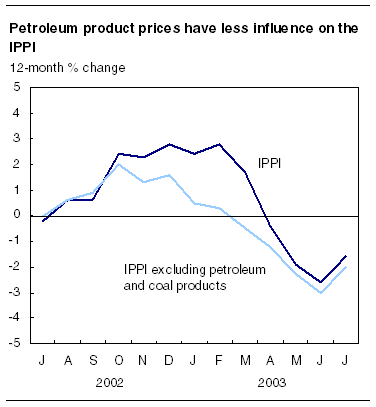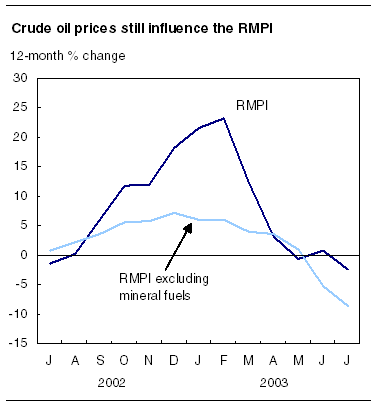
















 |
|
 |                |
Information identified as archived is provided for reference, research or recordkeeping purposes. It is not subject to the Government of Canada Web Standards and has not been altered or updated since it was archived. Please "contact us" to request a format other than those available.

|

Wednesday, September 3, 2003 Industrial product and raw materials price indexesJuly 2003Manufacturers' prices were up 1.3% in July but down 1.6% on an annual basis, largely due to the effect of the Canadian dollar against the US dollar. If the impact of the Canadian dollar is removed, the Industrial Product Price Index (IPPI) would have risen 1.0% rather than falling 1.6% from the previous year. 
From a monthly perspective, higher prices for motor vehicles and other transport equipment (+2.9%), lumber and other wood products (+3.6%) and primary metal products (+2.3%) were the major contributors to the increase in the IPPI. Prices for petroleum products also rose (+1.6%), as well as those for electrical and communication products (+1.7%). However, prices for meat, fish and dairy products were down 2.4% from June. Lower prices for beef products were responsible for this decrease, the result of the impact of last May's detection of a single case of bovine spongiform encephalopathy (BSE), or mad cow disease.
On an annual basis, lower prices for motor vehicles and other transport equipment (-6.2%), lumber and other wood products (-4.3%) and electrical and communication products (-4.0%) were the major contributors to the year-over-year decline in the IPPI. The petroleum and coal products group continues to have a smaller influence on the year-over-year change in the IPPI than it did for the first four months of 2003, with an increase of 3.3%. If petroleum and coal product prices had been excluded, the IPPI would have declined 2.0% instead of decreasing 1.6% on a year-over-year basis. In addition to petroleum and coal products, prices for chemical products (+3.2%) as well as tobacco products (+19.6%) were also up compared with the previous year. Lower cattle and calves prices push down raw materials pricesOn a monthly basis, raw materials prices were down 1.5% from June. Animals and animal products were the major contributors to the monthly decrease in the Raw Materials Price Index (RMPI), with prices decreasing 10.1%. Prices for cattle and calves for slaughter declined 43.8% from June, reflecting the effect of the discovery last May of a single case of BSE, or mad cow disease, in Alberta. Lower prices for vegetable products as well as wood products also contributed to the decline. Mineral fuels increased slightly by 0.1% as crude oil prices remained unchanged from June. Higher prices for non-ferrous metals and ferrous materials partly offset the monthly decrease. Manufacturers paid 2.4% less for their raw materials than they did in July last year, compared with an increase of 0.8% in June. Lower prices for animals and animal products (-14.2%) were mainly responsible for this annual drop in the RMPI. Prices for vegetable products, wood products and non-ferrous metals were also down on an annual basis. These decreases were partly offset by higher prices for mineral fuels (+5.6%) and non-metallic minerals (+5.8%). If mineral fuels had been excluded, the RMPI would have decreased 8.6%. The IPPI (1997=100) stood at 105.3 in July, up from its revised level of 104.0 in June. The RMPI (1997=100) was 110.0 in July down from its revised level of 111.7 in June. 
Impact of exchange rateBetween June and July, the value of the US dollar strengthened against the Canadian dollar, pushing up prices of commodities that are quoted in US dollars, notably motor vehicles and lumber products. As a result, the total IPPI excluding the effect of the exchange rate would have edged up 0.1% instead of increasing 1.3%. However, on a 12-month basis, the Canadian dollar is much stronger. Consequently, the IPPI excluding the effect of the exchange rate would have increased 1.0% rather than declining 1.6% from July 2002 to July 2003. Prices for intermediate goods decrease on an annual basisPrices for intermediate goods rose 1.1% from June. Higher prices for lumber products, motor vehicles, pulp and paper products, primary metal products as well as chemical products were the major contributors to the increase. Producers of intermediate goods received 1.3% less for their goods in July compared with the same month last year. Lower prices for motor vehicles, lumber products, pulp and paper products, primary metal products as well as electrical and communication products were partially offset by higher prices for petroleum and chemical products. "Intermediate goods," sometimes referred to as "input goods," are goods that are generally bought by manufacturers to be further used in the production process, that is, to make other goods. Finished goods continue to decrease from a year agoOn a monthly basis, prices for finished goods were up 1.5% from June. Higher prices for motor vehicles, petroleum products, electrical and communication products as well as machinery and equipment were the major contributors to this increase. Declining prices for motor vehicles, electrical and communication products, machinery and equipment as well as pulp and paper products pushed year-over-year prices down 2.1% from July 2002. These decreases were partly offset by higher prices for tobacco products, fruit, vegetable and feed products, chemical products as well as petroleum products. "Finished goods" are those generally purchased for the purpose of either consumption or investment. Most of the foods and feeds category ends up in the hands of consumers. Most capital goods are equipment and machinery generally bought by companies, government agencies, or governments. Much of the remainder is bought by consumers. Available on CANSIM: tables 329-0038 to 329-0049 and 330-0006. Definitions, data sources and methods: survey numbers, including related surveys, 2306 and 2318. The July 2003 issue of Industry price indexes (62-011-XIE, $17/$163; 62-011-XPE, $22/$217) will be available in September. For more information, or to enquire about the concepts, methods or data quality of this release, contact the Client Services Unit (613-951-9606; fax: 613-951-1539; infounit@statcan.gc.ca) or Danielle Gouin (613-951-3375; danielle.gouin@statcan.gc.ca), Prices Division.
| |||||||||||||||||||||||||||||||||||||||||||||||||||||||||||||||||||||||||||||||||||||||||||||||||||||||||||||||||||||||||||||||||||||||||||||||||||||||||||||||||||||||||||||||||||||||||||||||||||||||||||||||||||||||||||||||||||||||||||||||||||||||||||||||||||||||||||||||||||||||||||||||||||||||||||||||||||||||||||||||||||||||||||||||||||||||||||||||||||||||||||||||||
|
|
|